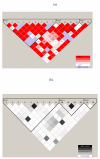A systematic search for SNPs/haplotypes associated with disease phenotypes using a haplotype-based stepwise procedure
- PMID: 19102730
- PMCID: PMC2680203
- DOI: 10.1186/1471-2156-9-90
A systematic search for SNPs/haplotypes associated with disease phenotypes using a haplotype-based stepwise procedure
Abstract
Background: Genotyping technologies enable us to genotype multiple Single Nucleotide Polymorphisms (SNPs) within selected genes/regions, providing data for haplotype association analysis. While haplotype-based association analysis is powerful for detecting untyped causal alleles in linkage-disequilibrium (LD) with neighboring SNPs/haplotypes, the inclusion of extraneous SNPs could reduce its power by increasing the number of haplotypes with each additional SNP.
Methods: Here, we propose a haplotype-based stepwise procedure (HBSP) to eliminate extraneous SNPs. To evaluate its properties, we applied HBSP to both simulated and real data, generated from a study of genetic associations of the bactericidal/permeability-increasing (BPI) gene with pulmonary function in a cohort of patients following bone marrow transplantation.
Results: Under the null hypothesis, use of the HBSP gave results that retained the desired false positive error rates when multiple comparisons were considered. Under various alternative hypotheses, HBSP had adequate power to detect modest genetic associations in case-control studies with 500, 1,000 or 2,000 subjects. In the current application, HBSP led to the identification of two specific SNPs with a positive validation.
Conclusion: These results demonstrate that HBSP retains the essence of haplotype-based association analysis while improving analytic power by excluding extraneous SNPs. Minimizing the number of SNPs also enables simpler interpretation and more cost-effective applications.
Figures


References
Publication types
MeSH terms
Grants and funding
LinkOut - more resources
Full Text Sources
Research Materials

